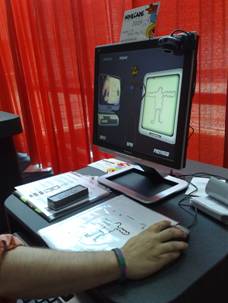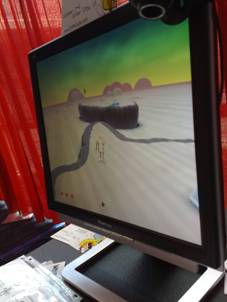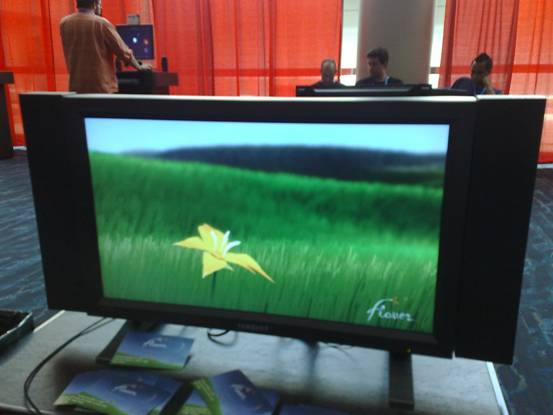SIGGRAPH 2009 New Orleans – Games
Written by Tng Tai Hou
Monday, 24 August 2009
SIGGRAPH 2009 in New Orleans had a games theme integrated into the mainstream conference. In addition to moving the ACM Sandbox Symposium into the conference proper, other games-related sessions included a keynote, papers, real-time rendering in games, and the 1st annual GameJam! game creation competition.
Sandbox hosted an IndieCade (www.indiecade.com) showcase of independent games. IndieCade bills itself as the only stand-alone independent Games Festival in the US and the only event of its type open to the public. On display were some of the selected games from IndieCade's repertoire:
"Zephyr: Tides of War" has a voice-driven interface, enabling the player to navigate a ship by shouting commands such as "Dive" or "U-Turn". I tried it and, in many cases, it worked for my Singaporean-accented English, with little need for repetition. This speaker-dependent design is great. Many voice-driven systems tend to achieve higher accuracies if the user "trains" the system to recognize voice patterns over a few hours of recording; "Zephyrr" requires no training. The voice input is via a conventional webcam with a built-in microphone. Despite the noisy environment, the simple voice commands were recognised and executed responsively. This interface was quite enjoyable and brought playability to a more engaging level.
"Papermint" is an appealing flat-3D style social networking environment. It is an MMO with paper dolls as characters. The developer incorporated emotive states into the paper dolls: if the "sad" state is chosen, the paper doll will be droopy-looking, choosing "happy" may cause the doll avatar to strut her stuff. The currency of the game is mint. There are opportunities for the avatar to earn some mint, but most of the mint can be found on the virtual ground.
"Path" is an interactive Red Riding Hood story with custom characters. Depending on how the player reacts and avoids the wolf determines which ending occurs. The gothic visual style of the game evoked comments such as "graphically wow", from some of the attendees. This is a horror-themed game. Where I grew up (Singapore), Red Riding Hood was a fairy tale and not a horror story - it did not even have images of the large-teeth wide-mouthed wolf on the cover. A brief look at "Path" will change the way one looks at fairy tales.
"Mightier" requires the user to draw (onto a paper within a registration box) an outline of a character and a number of plateaus. Using a webcam, the outline and plateaus are digitized and extruded into 3D. The user can then have his or her character jump onto the plateaus in order to capture power pods and move onto subsequent levels. The character in the game is flat and paper-thin. This game may encourage more children to use the pen to see how their drawings can be made interactive. The webcam digitization was fast and accurate - this was probably due to the registration boxes being within the supplied drawing material, which helped the software determine where the drawings should be recognised by the game.

 Sam Roberts, IndieCade Festival Director, hopes that SIGGRAPH attendees will use IndieCade as a platform to showcase new and innovative graphical games. This year he targeted IndieCade games at North American and UK markets. However, submissions came in from across the world. The submissions on display included entries from the US, Belgium, and Austria.
Within Sandbox were showcases of real-time rendering projects. One of the projects was "Flower" from That Game Company (www.thatgamecompany.com), which was originally an IndieCade project before it found a commercial path. In "Flower", the player navigates flower petals through a beautifully vivid and flowing grass landscape that is rendered in real-time.
Sam Roberts, IndieCade Festival Director, hopes that SIGGRAPH attendees will use IndieCade as a platform to showcase new and innovative graphical games. This year he targeted IndieCade games at North American and UK markets. However, submissions came in from across the world. The submissions on display included entries from the US, Belgium, and Austria.
Within Sandbox were showcases of real-time rendering projects. One of the projects was "Flower" from That Game Company (www.thatgamecompany.com), which was originally an IndieCade project before it found a commercial path. In "Flower", the player navigates flower petals through a beautifully vivid and flowing grass landscape that is rendered in real-time.
 ATI and nVidia both had real-time rendering demos running off their respective GPUs. nVidia's demo was a real-time 6 million triangle story about Medusa (who turned a lusty warrior into stone before then smashing him into pieces). Frame-rates ranged from 30 to 80 depending on scenes. Medusa first appeared rendered as an attractive character before morphing into a nightmare with a snake-like slithering hair-do.
The Froblins demo from AMD has 3000 highly detailed whimsical characters running around a landscape searching for gold, depositing it at temples, finding and consuming mushrooms, making their way back to camp and sleeping. Each Froblin could be rendered in as many as 1.6 million triangles depending on screen proximity. The GPU was not only used for rendering, but was also used for the computation of the behaviour of every single Froblin.
The Computer Animation Festival also previewed some of the real-time projects in (duh) real-time. The crowd in the Lousiana Theatre loved it. They were further impressed when EA's Fight Night 4 was shown, complete with visibly detailed renderings of Mike Tyson and Will Wright (of Simcity, The Sims, and Spore repute) having a go at each other.
Polhemus is a technology company specialising in motion tracking. The drum demonstration above utilises 6-DOF sensors attached to each stick. This enables the sticks to be tracked accurately as the user beats into the air. The slightly visible bulge under the tablecloth is the magnetic base station which serves as the point of origin.
Will Wright also gave a keynote on "Playing with Perceptions". He was one of the more entertaining speakers and knew his slides so well that he zipped right through over 240 of them, without a pause! After the first few minutes, one could argue that the content was not as important as the lesson in presentation skills. Here was a major figure in the games industry walking us through history lessons; showing images of convergence and evolution of the digital electronics, computer, and media worlds. It definitely helped that Will is clear in his articulation. A main point of his presentation was that game developers should take to the notion of an Entertainment Designer overseeing the entire game. The whole team of artists, programmers, 3D artists, developers, marketers, producers, funders, and management should look at the game as a whole and not in parts, a process to be galvanised into action by an overall Entertainment Designer.
Now we just have to persuade the industry to pay heed to the role of an "Entertainment Designer".
Tai Hou Tng
Writing on behalf of the Singapore ACM SIGGRAPH Chapter
taihou@gmail.com
ATI and nVidia both had real-time rendering demos running off their respective GPUs. nVidia's demo was a real-time 6 million triangle story about Medusa (who turned a lusty warrior into stone before then smashing him into pieces). Frame-rates ranged from 30 to 80 depending on scenes. Medusa first appeared rendered as an attractive character before morphing into a nightmare with a snake-like slithering hair-do.
The Froblins demo from AMD has 3000 highly detailed whimsical characters running around a landscape searching for gold, depositing it at temples, finding and consuming mushrooms, making their way back to camp and sleeping. Each Froblin could be rendered in as many as 1.6 million triangles depending on screen proximity. The GPU was not only used for rendering, but was also used for the computation of the behaviour of every single Froblin.
The Computer Animation Festival also previewed some of the real-time projects in (duh) real-time. The crowd in the Lousiana Theatre loved it. They were further impressed when EA's Fight Night 4 was shown, complete with visibly detailed renderings of Mike Tyson and Will Wright (of Simcity, The Sims, and Spore repute) having a go at each other.
Polhemus is a technology company specialising in motion tracking. The drum demonstration above utilises 6-DOF sensors attached to each stick. This enables the sticks to be tracked accurately as the user beats into the air. The slightly visible bulge under the tablecloth is the magnetic base station which serves as the point of origin.
Will Wright also gave a keynote on "Playing with Perceptions". He was one of the more entertaining speakers and knew his slides so well that he zipped right through over 240 of them, without a pause! After the first few minutes, one could argue that the content was not as important as the lesson in presentation skills. Here was a major figure in the games industry walking us through history lessons; showing images of convergence and evolution of the digital electronics, computer, and media worlds. It definitely helped that Will is clear in his articulation. A main point of his presentation was that game developers should take to the notion of an Entertainment Designer overseeing the entire game. The whole team of artists, programmers, 3D artists, developers, marketers, producers, funders, and management should look at the game as a whole and not in parts, a process to be galvanised into action by an overall Entertainment Designer.
Now we just have to persuade the industry to pay heed to the role of an "Entertainment Designer".
Tai Hou Tng
Writing on behalf of the Singapore ACM SIGGRAPH Chapter
taihou@gmail.com
|


 Sam Roberts, IndieCade Festival Director, hopes that SIGGRAPH attendees will use IndieCade as a platform to showcase new and innovative graphical games. This year he targeted IndieCade games at North American and UK markets. However, submissions came in from across the world. The submissions on display included entries from the US, Belgium, and Austria.
Within Sandbox were showcases of real-time rendering projects. One of the projects was "Flower" from That Game Company (www.thatgamecompany.com), which was originally an IndieCade project before it found a commercial path. In "Flower", the player navigates flower petals through a beautifully vivid and flowing grass landscape that is rendered in real-time.
Sam Roberts, IndieCade Festival Director, hopes that SIGGRAPH attendees will use IndieCade as a platform to showcase new and innovative graphical games. This year he targeted IndieCade games at North American and UK markets. However, submissions came in from across the world. The submissions on display included entries from the US, Belgium, and Austria.
Within Sandbox were showcases of real-time rendering projects. One of the projects was "Flower" from That Game Company (www.thatgamecompany.com), which was originally an IndieCade project before it found a commercial path. In "Flower", the player navigates flower petals through a beautifully vivid and flowing grass landscape that is rendered in real-time.
 ATI and nVidia both had real-time rendering demos running off their respective GPUs. nVidia's demo was a real-time 6 million triangle story about Medusa (who turned a lusty warrior into stone before then smashing him into pieces). Frame-rates ranged from 30 to 80 depending on scenes. Medusa first appeared rendered as an attractive character before morphing into a nightmare with a snake-like slithering hair-do.
The Froblins demo from AMD has 3000 highly detailed whimsical characters running around a landscape searching for gold, depositing it at temples, finding and consuming mushrooms, making their way back to camp and sleeping. Each Froblin could be rendered in as many as 1.6 million triangles depending on screen proximity. The GPU was not only used for rendering, but was also used for the computation of the behaviour of every single Froblin.
The Computer Animation Festival also previewed some of the real-time projects in (duh) real-time. The crowd in the Lousiana Theatre loved it. They were further impressed when EA's Fight Night 4 was shown, complete with visibly detailed renderings of Mike Tyson and Will Wright (of Simcity, The Sims, and Spore repute) having a go at each other.
Polhemus is a technology company specialising in motion tracking. The drum demonstration above utilises 6-DOF sensors attached to each stick. This enables the sticks to be tracked accurately as the user beats into the air. The slightly visible bulge under the tablecloth is the magnetic base station which serves as the point of origin.
Will Wright also gave a keynote on "Playing with Perceptions". He was one of the more entertaining speakers and knew his slides so well that he zipped right through over 240 of them, without a pause! After the first few minutes, one could argue that the content was not as important as the lesson in presentation skills. Here was a major figure in the games industry walking us through history lessons; showing images of convergence and evolution of the digital electronics, computer, and media worlds. It definitely helped that Will is clear in his articulation. A main point of his presentation was that game developers should take to the notion of an Entertainment Designer overseeing the entire game. The whole team of artists, programmers, 3D artists, developers, marketers, producers, funders, and management should look at the game as a whole and not in parts, a process to be galvanised into action by an overall Entertainment Designer.
Now we just have to persuade the industry to pay heed to the role of an "Entertainment Designer".
Tai Hou Tng
Writing on behalf of the Singapore ACM SIGGRAPH Chapter
taihou@gmail.com
ATI and nVidia both had real-time rendering demos running off their respective GPUs. nVidia's demo was a real-time 6 million triangle story about Medusa (who turned a lusty warrior into stone before then smashing him into pieces). Frame-rates ranged from 30 to 80 depending on scenes. Medusa first appeared rendered as an attractive character before morphing into a nightmare with a snake-like slithering hair-do.
The Froblins demo from AMD has 3000 highly detailed whimsical characters running around a landscape searching for gold, depositing it at temples, finding and consuming mushrooms, making their way back to camp and sleeping. Each Froblin could be rendered in as many as 1.6 million triangles depending on screen proximity. The GPU was not only used for rendering, but was also used for the computation of the behaviour of every single Froblin.
The Computer Animation Festival also previewed some of the real-time projects in (duh) real-time. The crowd in the Lousiana Theatre loved it. They were further impressed when EA's Fight Night 4 was shown, complete with visibly detailed renderings of Mike Tyson and Will Wright (of Simcity, The Sims, and Spore repute) having a go at each other.
Polhemus is a technology company specialising in motion tracking. The drum demonstration above utilises 6-DOF sensors attached to each stick. This enables the sticks to be tracked accurately as the user beats into the air. The slightly visible bulge under the tablecloth is the magnetic base station which serves as the point of origin.
Will Wright also gave a keynote on "Playing with Perceptions". He was one of the more entertaining speakers and knew his slides so well that he zipped right through over 240 of them, without a pause! After the first few minutes, one could argue that the content was not as important as the lesson in presentation skills. Here was a major figure in the games industry walking us through history lessons; showing images of convergence and evolution of the digital electronics, computer, and media worlds. It definitely helped that Will is clear in his articulation. A main point of his presentation was that game developers should take to the notion of an Entertainment Designer overseeing the entire game. The whole team of artists, programmers, 3D artists, developers, marketers, producers, funders, and management should look at the game as a whole and not in parts, a process to be galvanised into action by an overall Entertainment Designer.
Now we just have to persuade the industry to pay heed to the role of an "Entertainment Designer".
Tai Hou Tng
Writing on behalf of the Singapore ACM SIGGRAPH Chapter
taihou@gmail.com